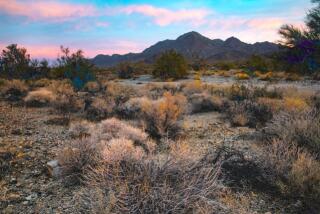Area With Colorful Past Could Be Preserved for Future
- Share via
Native Americans once built a thriving village in the shadow of the jutting boulders in what is now Chatsworth. Later, Californios raised adobe homes. Then came the stagecoaches, rattling across steep and rocky roads.
Now, about 670 acres of grassy trails and sandstone bluffs tucked in the hills above Chatsworth are set to take on their next role: the state’s newest historic park.
The designation, expected to come Tuesday at a California State Park and Recreation Commission meeting, will not bring any immediate improvements to the site just south of Santa Susana Pass Road. Nonetheless, park boosters call it an important first step.
“I’m thrilled,” said Janice Hinkston, who began working in 1970 to win recognition of the tract. “People have thought I was dreaming the impossible dream, but it was just too important to give up.”
Supporters have at least one fear about the area’s increased visibility, though. Past publicity has brought vandals, who spray painted rocks, and pot hunters, who dug up chunks of earth in a search for artifacts. Such excavation is illegal and carries the possibility of a two-year prison sentence or a stiff fine.
Filled with steep cliffs, sharp ridges and abundant wildlife, the area’s varied geography is matched by a rich history dating back thousands of years, when it served as a border outpost of the Chumash and Tongva Indian cultures. The site, which shows influences of both cultures, was a sort of ancient Tijuana where two cultures often met; it numbered 50 to a few hundred people, archeologists say.
In the late 1700s and early 1800s, Spanish explorers began traveling through the area, and by 1804, the Santa Susana Pass was mentioned as one of the primary north-south routes between Los Angeles and the rest of the state.
Several important roads were eventually built through the area, despite a treacherously steep portion of the pass at the western end of the park called “Devil’s Slide.”
The section was so pitched that stagecoaches were lowered down it by hand.
In modern history, the area served as a quarry for much of the rock used in the building of the Los Angeles harbor.
“Other than Olvera [Street], this is the largest concentration of historic sites in Los Angeles,” said Al Knight, an archeologist who has spent the past seven years documenting the park’s history.
The drive to set the area aside as a park began in 1970, when Hinkston was a kindergarten teacher at Chatsworth Park Elementary.
For the next two decades, she threw herself into the project, marshaling a legion of volunteers to serve in the Santa Susana Mountain Park Assn. Over the years, Hinkston said, she turned down two wedding proposals from suitors who wanted to take her away from her beloved park. Only recently did she move to Oregon to be with her daughter and 5-year-old grandson.
“I still am very passionate about it,” said Hinkston, who plans to fly down for Tuesday’s hearing in Valencia. “I love the rocks and the land and the history.”
Although state park officials were at first reluctant to become involved with a project so close to an urban area, they began buying up land in 1979. Tracts came in bits and pieces, with a 34-acre section in the process of being added even now.
There were plenty of battles with developers. One wanted to build a mobile home park. Another wanted a series of luxury homes catering to equestrians.
The project also labored in the shadow of better-known conservation battles in the Santa Monica Mountains. “It was never easy,” archeologist Knight said.
On a recent hike, Knight showed off the potential of the park, which is already open to the public, though hardly marked with distinction. One entrance is through a tear in a chain link fence near the foot of Lassen Street and Valley Circle Boulevard. Another is in Ventura County, at the foot of Lilac Lane.
The 1,700-foot peaks of the Simi Hills form the backdrop, encircling the park with a massive, red-orange wall. The ramparts in the park were formed about 5 million years ago by mountain-building forces shoving the earth upward, according to a state report.
The park association offers weekly tours through the area, which is laced with trails. In addition, hikers, joggers and equestrians use the proposed park on a routine basis. Knight estimates there are 10,000 to 20,000 visitors a year.
More to Read
Sign up for The Wild
We’ll help you find the best places to hike, bike and run, as well as the perfect silent spots for meditation and yoga.
You may occasionally receive promotional content from the Los Angeles Times.






